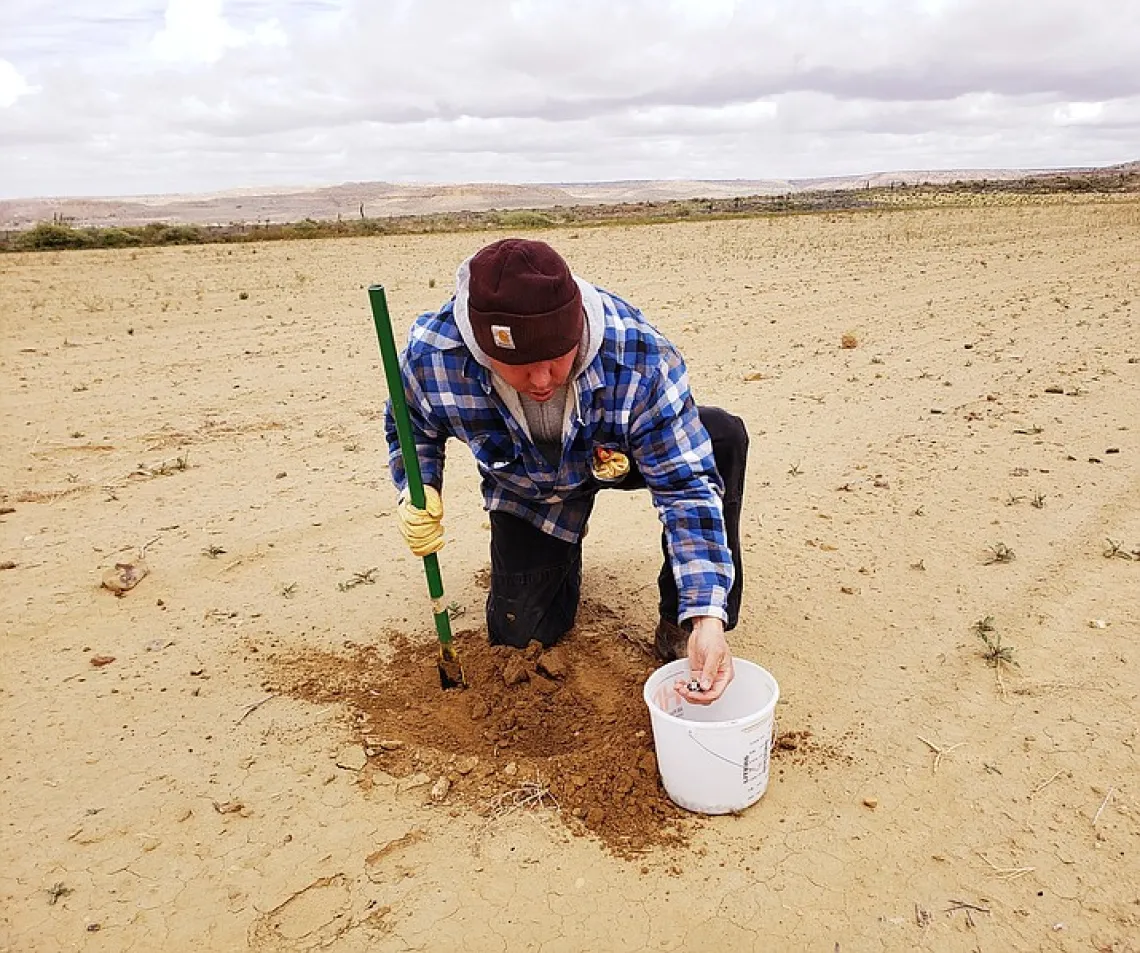Adapting to climate change on Hopi
Hopi Three Mesas and Hopi youth to build climate change plan in face of dwindling crops

Michael Kotutwa Johnson plants corn on the Hopi reservation in Oraibi Valley between second and third mesa.
MIchael Kotutwa Johnson
SECOND MESA , Ariz. — Hopi Three Mesas (H3M) received a $100,000 grant from the First Nations Development Institute for the creation of a climate change mitigation plan for Hopi.
The money will be used to educate Hopi youth about climate change and the impacts to the Hopi agricultural growing season and corn farming.
Hopi Three Mesas will select 10 youth, ages 12 to 18, to become climate stewards, develop an outreach campaign and learn about traditional Hopi corn farming.
The award will support the efforts of Youth for the Future: Educating Hopi 4-H Healthy Living Ambassadors for a Sustainable Future.
“That's where we started working with the youth two years ago,” said Bonnie Secakuku, founder of Hopi Three Mesas. “The students that join the project determine what healthy living means to them and carry out a project for a year.”
Hopi Three Mesas was established in 2014 with the mission to strength and revitalize Hopi culture, language and life. It dedicates its resources to improving the general welfare, health, safety and social and economic stability of Hopi villages, the Hopi Tribe, and its members.
The organization recently added a youth component, the Hopi Youth Club, to focus on getting youth involved so they can play a part in the process.
“We felt that it’s important for our youth to understand there’s a change in the weather and it's up to them to help sustain their future,” Secakuku said.
Sustaining corn on the Hopi reservations’s 8.5 inches of average annual precipitation is already a challenge; however, that's made more difficult by climate change. Temperatures in recent decades on the reservation have been “much warmer than any other period in the past 115 years,” according to a 2015 study by the University of Arizona.
Four of the top five warmest years on the Hopi Reservation all occurred since the late 1990s, the study found.
Warmer temperatures increase evapotranspiration and place more stress on crops and the region according to the report. However, higher temperatures are just part of the issue — less snowfall over the winter and the growing season becoming shorter are two of the major reasons Hopi corn yields are decreasing, according to Dr. Michael Kotutwa Johnson, a Hopi farmer and Indigenous resilience specialist with the University of Arizona.
“The Hopi people are producing less (corn) that's obvious and something I've seen firsthand,” said Johnson, who farms between Second and Third Mesa. “Sometimes you don't even have a crop because you don't have enough moisture available. … (It’s) starting to impact what we can provide our people and our dancers at ceremonies.”
Snowfall
While summer precipitation has been active this year, Johnson points out the monsoon doesn’t do much good if there are no plants to uptake the water and fill out the cobs. Winter snowfall is critical to supplying soil moisture for crop growth “and we just haven't had that in the last few years,” he said.
A long-term decrease in annual snowfall and a decline in surface water was among the most cited ecological changes over the last century, according to a 2014 study in Cambridge University Press which interviewed 73 elders from the surrounding Navajo Nation.
The lack of available water, in addition to changing socioeconomic conditions, was mentioned as a leading cause for the decline in the ability to grow corn and other crops, the study found.
“Changes in the frequency of wind, sand and dust storms (more frequent in the 1950s and increasing in the 1990s) were also observed. We conclude that a long-term drying trend and decreasing snowpack, superimposed on regional drought cycles, will magnify the cultural erosion and desertification of the Navajo Nation and leave its people increasingly vulnerable to climate extremes.”
Wind
Another concern for H3M is the effects of wind on soil. High winds dry out soil and is made worse by vegetation removal.
“When you're in drought you don't have the vegetation to hold soils down,” Johnson said. “This year we had winds all the way from March all the way pretty much through May. Usually we only have winds during March and our planning season starts in April.”
It's here that socioeconomic issues become fundamentally linked with northern Arizona’s landscape. Vegetation removal on the Hopi reservation increases wind speed and appears to have three major drivers: drought killing vegetation, overgrazing by cattle and residents cutting trees for heating and domestic use.
The shuttering of area coal mines has forced many residents to cut wood for heating, which increase the impact of wind on soil but will decrease climate change’s effects, according to H3M and Johnson
Wind drying out the soil caused some area farmers to delay planting this year and others to plant deeper. But it’s deep cultural roots that sustain the Hopi as a people and their decision to forgo irrigating their crops, Johnson said.
“We've been farmers since the get go,” Johnson said. “There's no separation between our agricultural system and our belief systems. They are tied together and they support each other. That's what makes Hopi farming so resilient over thousands of years is that there’s an underlying cultural belief system that supports us planting every year.”
Secakuku is still looking for participants who are willing to commit a year to the program. She can be reached at bjsecakuku@yahoo.com or (928) 255-2572.
https://www.nhonews.com/news/2022/oct/25/adapting-climate-change-hopi/
